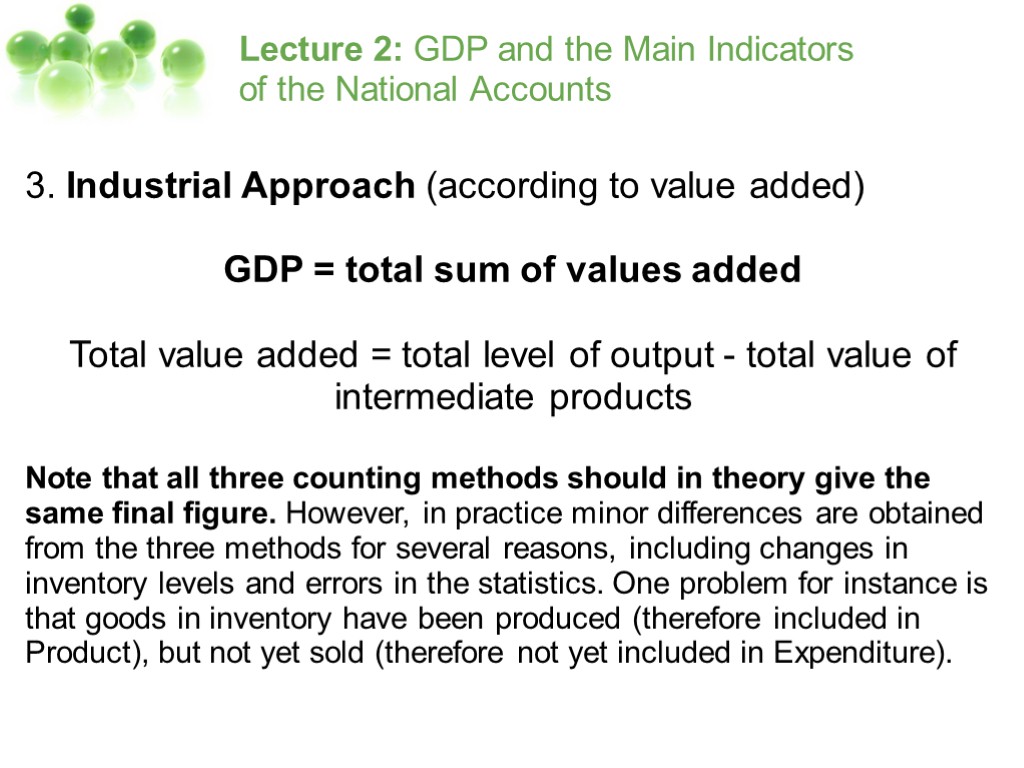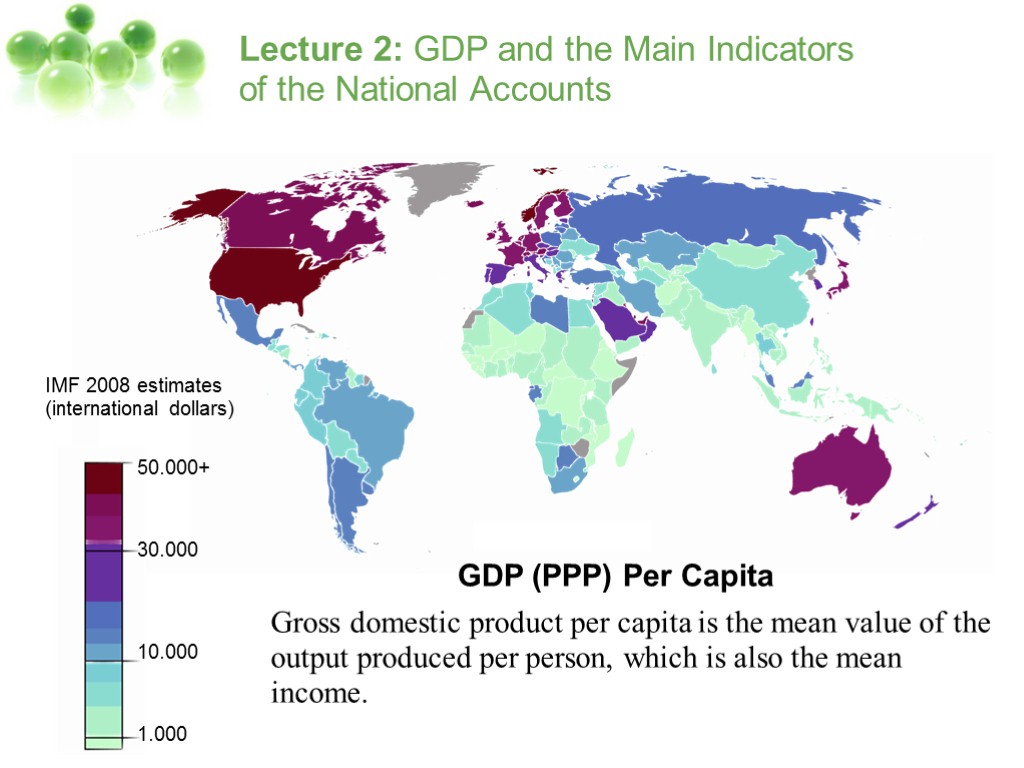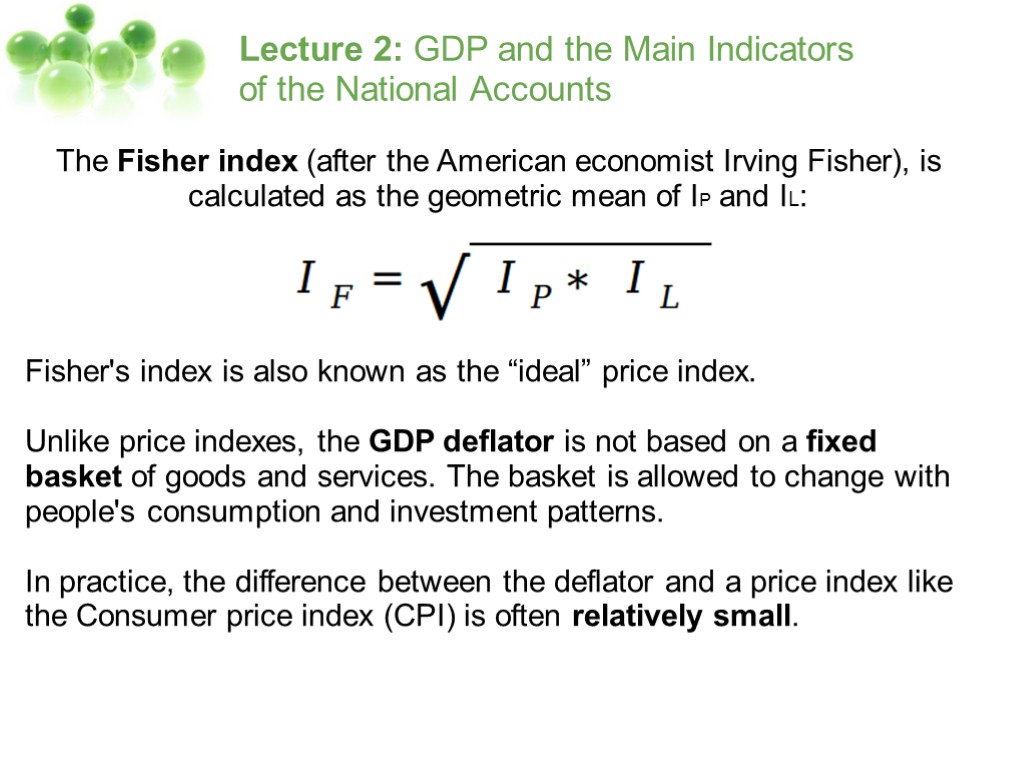Lecture 2 GDP and the Main Indicators of

















lecture_2_gdp_and_the_main_indicators_of_the.ppt
- Количество слайдов: 16
 Lecture 2 GDP and the Main Indicators of the National Accounts
Lecture 2 GDP and the Main Indicators of the National Accounts
 Lecture 2: GDP and the Main Indicators of the National Accounts 1. GDP and the Ways of Its Measuring. 2. GNP and the Other Indicators Used in National Accounts 3. Nominal & Real GDP. The Price indexes.
Lecture 2: GDP and the Main Indicators of the National Accounts 1. GDP and the Ways of Its Measuring. 2. GNP and the Other Indicators Used in National Accounts 3. Nominal & Real GDP. The Price indexes.
 Lecture 2: GDP and the Main Indicators of the National Accounts Depreciation – амортизація Net Indirect Taxes – непрямі податки Social Insurance Premium – внески на соціальне страхування Earned Surplus of Corporations – нерозподілений прибуток корпорацій Income Tax – прибутковий податок Corporate Income Tax – податок на прибуток корпорацій Net Factor Income From Abroad – чистий факторний прибуток з-за кордону
Lecture 2: GDP and the Main Indicators of the National Accounts Depreciation – амортизація Net Indirect Taxes – непрямі податки Social Insurance Premium – внески на соціальне страхування Earned Surplus of Corporations – нерозподілений прибуток корпорацій Income Tax – прибутковий податок Corporate Income Tax – податок на прибуток корпорацій Net Factor Income From Abroad – чистий факторний прибуток з-за кордону
 Lecture 2: GDP and the Main Indicators of the National Accounts The gross domestic product (GDP) or gross domestic income (GDI) is a measure of a country's overall official economic output. It is the market value of all final goods and services officially made within the borders of a country in a year. It is often positively correlated with the standard of living, though its use as a stand-in for measuring the standard of living has come under increasing criticism and many countries are actively exploring alternative measures to GDP for that purpose.
Lecture 2: GDP and the Main Indicators of the National Accounts The gross domestic product (GDP) or gross domestic income (GDI) is a measure of a country's overall official economic output. It is the market value of all final goods and services officially made within the borders of a country in a year. It is often positively correlated with the standard of living, though its use as a stand-in for measuring the standard of living has come under increasing criticism and many countries are actively exploring alternative measures to GDP for that purpose.
 Lecture 2: GDP and the Main Indicators of the National Accounts GDP can be determined in three ways, all of which should in principle give the same result. They are the industrial (or output) approach, the income approach, and the expenditure approach. 1. Expenditure approach Y = C + I + G + (X − M) GDP (Y) is a sum of Consumption (C), Investment (I), Government Spending (G) and Net Exports (X - M).
Lecture 2: GDP and the Main Indicators of the National Accounts GDP can be determined in three ways, all of which should in principle give the same result. They are the industrial (or output) approach, the income approach, and the expenditure approach. 1. Expenditure approach Y = C + I + G + (X − M) GDP (Y) is a sum of Consumption (C), Investment (I), Government Spending (G) and Net Exports (X - M).
 Lecture 2: GDP and the Main Indicators of the National Accounts 2. Income approach GDP = R + I + P + SA + W here R: rents I: interests P: profits SA: statistical adjustments (corporate income taxes, dividends, undistributed corporate profits, depresiation, indirect taxes) W: wages Note the mnemonic, "ripsaw".
Lecture 2: GDP and the Main Indicators of the National Accounts 2. Income approach GDP = R + I + P + SA + W here R: rents I: interests P: profits SA: statistical adjustments (corporate income taxes, dividends, undistributed corporate profits, depresiation, indirect taxes) W: wages Note the mnemonic, "ripsaw".
 Lecture 2: GDP and the Main Indicators of the National Accounts 3. Industrial Approach (according to value added) GDP = total sum of values added Total value added = total level of output - total value of intermediate products Note that all three counting methods should in theory give the same final figure. However, in practice minor differences are obtained from the three methods for several reasons, including changes in inventory levels and errors in the statistics. One problem for instance is that goods in inventory have been produced (therefore included in Product), but not yet sold (therefore not yet included in Expenditure).
Lecture 2: GDP and the Main Indicators of the National Accounts 3. Industrial Approach (according to value added) GDP = total sum of values added Total value added = total level of output - total value of intermediate products Note that all three counting methods should in theory give the same final figure. However, in practice minor differences are obtained from the three methods for several reasons, including changes in inventory levels and errors in the statistics. One problem for instance is that goods in inventory have been produced (therefore included in Product), but not yet sold (therefore not yet included in Expenditure).
 Lecture 2: GDP and the Main Indicators of the National Accounts IMF 2008 estimates (international dollars) GDP (PPP) Per Capita 50.000+ 30.000 10.000 Gross domestic product per capita is the mean value of the output produced per person, which is also the mean income. 1.000
Lecture 2: GDP and the Main Indicators of the National Accounts IMF 2008 estimates (international dollars) GDP (PPP) Per Capita 50.000+ 30.000 10.000 Gross domestic product per capita is the mean value of the output produced per person, which is also the mean income. 1.000
 Lecture 2: GDP and the Main Indicators of the National Accounts Gross National Product GDP can be contrasted with gross national product (GNP). GDP is product produced within a country's borders; GNP is product produced by enterprises owned by a country's citizens. Gross national product (GNP) equals GDP plus income receipts from the rest of the world minus income payments to the rest of the world. GDP = GNP + NFIA (net factor income from abroad)
Lecture 2: GDP and the Main Indicators of the National Accounts Gross National Product GDP can be contrasted with gross national product (GNP). GDP is product produced within a country's borders; GNP is product produced by enterprises owned by a country's citizens. Gross national product (GNP) equals GDP plus income receipts from the rest of the world minus income payments to the rest of the world. GDP = GNP + NFIA (net factor income from abroad)
 Lecture 2: GDP and the Main Indicators of the National Accounts The Net Domestic Product "Net" means "Gross" minus the amount that must be used to offset depreciation – ie., wear-and-tear or obsolescence of the nation's fixed capital assets. "Net" gives an indication of how much product is actually available for consumption or new investment. The NDP is defined as the GDP less capital consumption. NDP = GDP – Depreciation National Income National income is an economics term encompassed the income of households, businesses, and the government. National income (NI) = NDP – Net Indirect Taxes
Lecture 2: GDP and the Main Indicators of the National Accounts The Net Domestic Product "Net" means "Gross" minus the amount that must be used to offset depreciation – ie., wear-and-tear or obsolescence of the nation's fixed capital assets. "Net" gives an indication of how much product is actually available for consumption or new investment. The NDP is defined as the GDP less capital consumption. NDP = GDP – Depreciation National Income National income is an economics term encompassed the income of households, businesses, and the government. National income (NI) = NDP – Net Indirect Taxes
 Lecture 2: GDP and the Main Indicators of the National Accounts Private Income Private income is any type of income received by a private individual or household, often derived from occupational activities. PI = NI – Social Insurance Premium – Earned Surplus of Corporations – Corporate Income Tax + Transfer Payments Disposable Income (Personal) Disposable Income – the money a person has available to spend after paying taxes, pension contributions, etc. DI = PI – Income Tax
Lecture 2: GDP and the Main Indicators of the National Accounts Private Income Private income is any type of income received by a private individual or household, often derived from occupational activities. PI = NI – Social Insurance Premium – Earned Surplus of Corporations – Corporate Income Tax + Transfer Payments Disposable Income (Personal) Disposable Income – the money a person has available to spend after paying taxes, pension contributions, etc. DI = PI – Income Tax
 Lecture 2: GDP and the Main Indicators of the National Accounts In economics, nominal value refers to a value expressed in money of the year, as opposed to real value, which adjusts for the effect of inflation on the nominal value. In most systems of national accounts the GDP deflator measures the ratio of nominal GDP to the real measure of GDP. The formula used to calculate the deflator is: Dividing the nominal GDP by the GDP deflator and multiplying it by 100 would then give the figure for real GDP, hence deflating the nominal GDP into a real measure.
Lecture 2: GDP and the Main Indicators of the National Accounts In economics, nominal value refers to a value expressed in money of the year, as opposed to real value, which adjusts for the effect of inflation on the nominal value. In most systems of national accounts the GDP deflator measures the ratio of nominal GDP to the real measure of GDP. The formula used to calculate the deflator is: Dividing the nominal GDP by the GDP deflator and multiplying it by 100 would then give the figure for real GDP, hence deflating the nominal GDP into a real measure.
 Lecture 2: GDP and the Main Indicators of the National Accounts A consumer price index (CPI) measures changes through time in the price level of consumer goods and services purchased by households. The CPI is defined as a measure of the average change over time in the prices paid by urban consumers for a market basket of consumer goods and services. It calculates like the Laspeyres (after the German economist Etienne Laspeyres) index: where P – is price Q– is quality 0 & t – are the basic period and the current period relatively.
Lecture 2: GDP and the Main Indicators of the National Accounts A consumer price index (CPI) measures changes through time in the price level of consumer goods and services purchased by households. The CPI is defined as a measure of the average change over time in the prices paid by urban consumers for a market basket of consumer goods and services. It calculates like the Laspeyres (after the German economist Etienne Laspeyres) index: where P – is price Q– is quality 0 & t – are the basic period and the current period relatively.
 Lecture 2: GDP and the Main Indicators of the National Accounts While the Paasche (after the German economist Hermann Paasche) index is computed as: Note that the only difference in the formulas is that the former uses period t quantities, whereas the latter uses base period (period 0) quantities. The Laspeyres index systematically overstates inflation, while the Paasche index understates it, because the indices do not account for the fact that consumers typically react to price changes by changing the quantities that they buy. For example, if prices go up for good c then, quantities of that good should go down.
Lecture 2: GDP and the Main Indicators of the National Accounts While the Paasche (after the German economist Hermann Paasche) index is computed as: Note that the only difference in the formulas is that the former uses period t quantities, whereas the latter uses base period (period 0) quantities. The Laspeyres index systematically overstates inflation, while the Paasche index understates it, because the indices do not account for the fact that consumers typically react to price changes by changing the quantities that they buy. For example, if prices go up for good c then, quantities of that good should go down.
 Lecture 2: GDP and the Main Indicators of the National Accounts The Fisher index (after the American economist Irving Fisher), is calculated as the geometric mean of IP and IL: Fisher's index is also known as the “ideal” price index. Unlike price indexes, the GDP deflator is not based on a fixed basket of goods and services. The basket is allowed to change with people's consumption and investment patterns. In practice, the difference between the deflator and a price index like the Consumer price index (CPI) is often relatively small.
Lecture 2: GDP and the Main Indicators of the National Accounts The Fisher index (after the American economist Irving Fisher), is calculated as the geometric mean of IP and IL: Fisher's index is also known as the “ideal” price index. Unlike price indexes, the GDP deflator is not based on a fixed basket of goods and services. The basket is allowed to change with people's consumption and investment patterns. In practice, the difference between the deflator and a price index like the Consumer price index (CPI) is often relatively small.
 The End
The End

